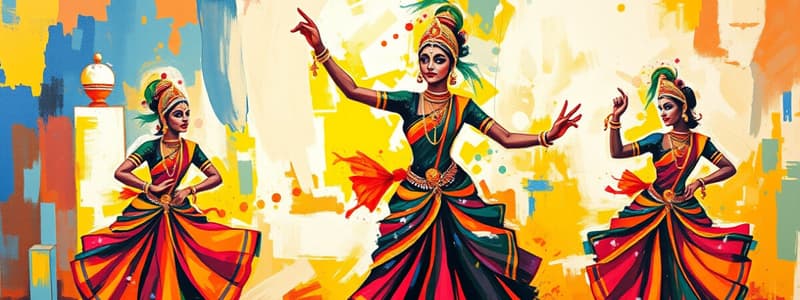Podcast
Questions and Answers
What was the primary context in which Bharatnatyam was originally performed?
What was the primary context in which Bharatnatyam was originally performed?
- By royal courts for noble guests
- As a form of modern entertainment
- In community festivals to celebrate harvests
- In Hindu temples as a form of worship (correct)
What did the British colonial rule lead to regarding the status of Bharatnatyam?
What did the British colonial rule lead to regarding the status of Bharatnatyam?
- Decline in status and scrutiny of temple practices (correct)
- A fusion with Western dance styles
- Its complete abandonment by practitioners
- Increased support and recognition from the government
Who played a crucial role in the revival and reformation of Bharatnatyam in the early 20th century?
Who played a crucial role in the revival and reformation of Bharatnatyam in the early 20th century?
- Kumudini Lakhia
- Balasaraswati
- Rukmini Devi Arundale (correct)
- Alarmel Valli
Which aspect of Bharatnatyam is emphasized through facial expressions?
Which aspect of Bharatnatyam is emphasized through facial expressions?
How has Bharatnatyam's status changed in the modern era?
How has Bharatnatyam's status changed in the modern era?
Flashcards are hidden until you start studying
Study Notes
History of Bharatnatyam
-
Origins:
- Bharatnatyam is one of the oldest classical dance forms of India, originating in Tamil Nadu.
- Traces back to the Natya Shastra, an ancient treatise on performing arts written by Bharata Muni around 200 BCE to 200 CE.
-
Traditional Context:
- Initially performed by Devadasis (temple dancers) in Hindu temples as a form of worship.
- The dance was meant to convey religious themes and stories from Hindu mythology.
-
Colonial Impact:
- The British colonial rule in India led to a decline in the status of the dance.
- It was associated with temple practices, which faced scrutiny and suppression during colonial times.
-
Revival:
- In the early 20th century, leaders such as Rukmini Devi Arundale played a crucial role in reviving and redefining Bharatnatyam.
- The dance was restructured, emphasizing its artistic and cultural significance rather than its religious origins.
-
Modern Era:
- Bharatnatyam gained popularity beyond India, becoming a symbol of Indian culture.
- Today, it is performed globally, showcasing its rich heritage and evolution.
-
Notable Figures:
- Rukmini Devi Arundale: Key in the revival and reformation of Bharatnatyam.
- Other influential dancers include Balasaraswati, Kumudini Lakhia, and Alarmel Valli.
-
Cultural Significance:
- Bharatnatyam serves as a medium for storytelling, expressing emotions and themes through facial expressions (abhinaya) and intricate footwork.
- It is recognized as a significant part of India's cultural heritage and continues to evolve while retaining its traditional roots.
Origins
- Bharatnatyam, rooted in Tamil Nadu, is one of India's oldest classical dance forms.
- Originates from the Natya Shastra, written by Bharata Muni between 200 BCE and 200 CE.
Traditional Context
- Initially performed by Devadasis, temple dancers who used the art form for worship.
- Focused on conveying religious themes and stories from Hindu mythology through dance.
Colonial Impact
- British colonial rule led to the decline of Bharatnatyam's status as it was associated with temple practices facing scrutiny.
- Suppression during colonial times impacted the performance and preservation of this dance form.
Revival
- Early 20th century saw a significant revival led by figures like Rukmini Devi Arundale.
- The dance was restructured to highlight artistic and cultural significance, moving away from its purely religious origins.
Modern Era
- Bharatnatyam's popularity expanded globally, symbolizing Indian culture.
- Currently performed worldwide, it showcases a rich heritage while embracing evolution.
Notable Figures
- Rukmini Devi Arundale played a key role in Bharatnatyam's revival and reformation.
- Other influential dancers include Balasaraswati, Kumudini Lakhia, and Alarmel Valli, each contributing to its development.
Cultural Significance
- Served as a medium for storytelling, expressing emotions through facial expressions (abhinaya) and intricate footwork.
- Recognized as an essential part of India's cultural heritage, it continues to evolve while maintaining traditional roots.
Studying That Suits You
Use AI to generate personalized quizzes and flashcards to suit your learning preferences.



